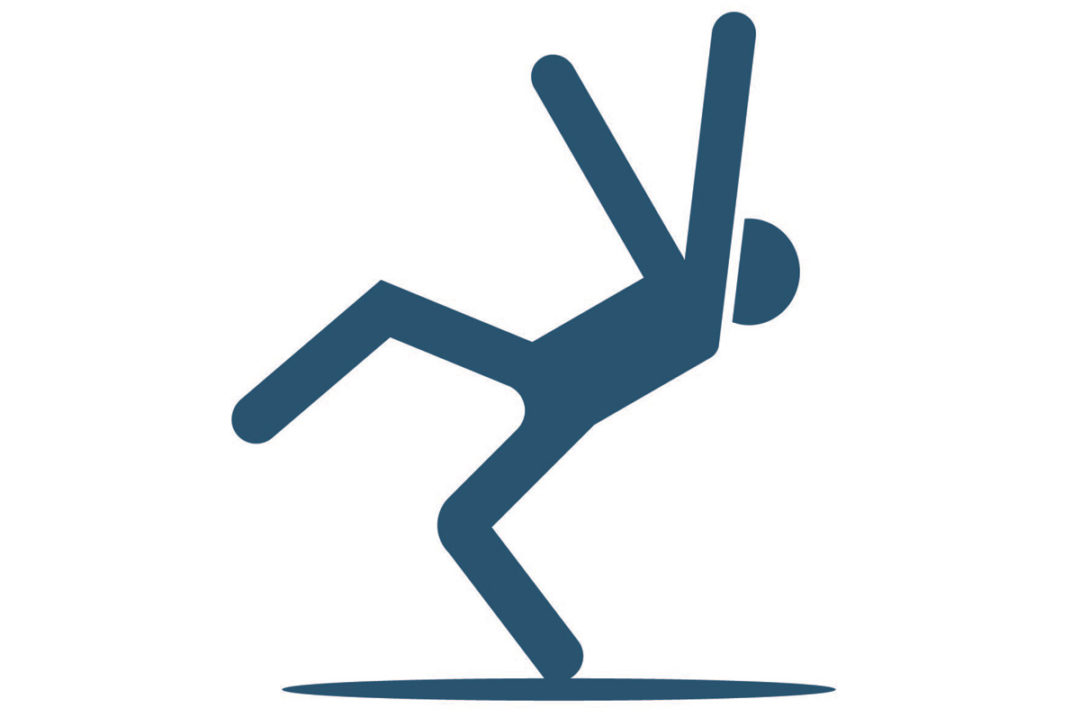To read this article in French, click here.
What causes the highest number of human injuries on dairies? Most of us think of machinery or confined spaces, but cattle actually hold the No. 1 position. Now, if I asked what causes the second-highest number of injuries, what would be your response? If you said slips, trips and falls, then you are correct. Workers’ compensation claims show us that cattle are the No. 1 cause of human injuries on dairies, but slips, trips and falls hold a strong No. 2 position. Does this surprise you?
We typically do not spend a lot of time discussing slips, trips and falls hazards with employees. Maybe it is overlooked because these hazards are not necessarily unique to the dairy industry. Maybe we do not provide extensive training in slips, trips and falls prevention because it is common sense. Regardless of the reason, let’s spend some time right now focusing on slips, trips and falls. It could save someone’s life.
Slips
A slip is when you lose your footing. I am sure we can all remember a time or two when we slipped on something at the farm. Whether it was ice, standing water, manure or even afterbirth from a calving that was the culprit, slipping is not a great feeling. You have seconds to realize you are slipping and respond accordingly to prevent a fall. Research has shown that occurrences of slipping accidents can be reduced by designing facilities with grooved flooring and proper drainage to prevent standing water.
Of course, nothing beats a good pair of non-slip boots. Having decent traction is a great start to preventing slips. Finding the perfect pair of boots is a victory, but let’s remember to replace those good ol’ boots once they start to get worn. The number of miles walked and the area of the worn region on the bottom of the boots are the best indicators it is time to find a new pair. Age of the boots is not a good indicator.
 Getty Images.
Getty Images.
Trips
Tripping occurs when you catch your foot on or in something. For me, tripping on hoses comes to mind immediately. I bet extension cords or wire might also come to your mind as tripping hazards. Just as with slips, trips give you mere seconds to react.
What can we do to prevent trips? From a building design standpoint, flooring should be fairly even without small steps or elevations, and handrails should be provided when moderate or greater elevations in flooring are present. Encourage everyone on the farm to keep things tidy. There is no need for random wires or baling twine to be scattered about the floors. Hoses should be rolled up when not in use. Try to keep extension cords up off the ground; otherwise use brightly colored cords or mark them for visibility. This may seem like common sense to you, but it might not be for any of your new employees. The key to prevention is education.
 Getty Images.
Getty Images.Falls
A fall is when you come down to the ground suddenly. Falls are the most severe compared to slips and trips, leading to more serious injuries. While slipping is not a great feeling, falling can be a terrifying feeling. Two types of falls occur: falling at the same level and falling to a lower level. An example of falling at the same level would be slipping on water and falling to the same ground you were just walking on, whereas falling from a ladder to the ground would be an example of falling to a lower level.
We already discussed how to prevent slips and trips that could lead to falls, so let’s direct our attention to falling to a lower level. If you are climbing a ladder or steps to a tractor, for example, keep the “three-point contact” rule in mind. This rule means that you always have three points of contact with the ladder, whether it be your two feet and one hand or two hands and one foot. Remind your employees to use ladders only on even surfaces and preferably in the presence of a co-worker.
Prevention
Preventing slips, trips and falls on the dairy requires everyone’s attention. Most slips, trips and falls injuries occur because the person did not perceive or recognize the hazard. In some cases, the person was not paying attention, and in other cases the hazard was not visible. Providing good lighting can help with this problem.
I have a great example to share related to lighting. My colleagues from the University of Washington Pacific Northwest Agricultural Safety and Health Center have an impactful mapping activity they use during dairy safety trainings. We were co-hosting a slips, trips and falls training on a dairy and introduced the mapping activity. Essentially, we provided a map that included the main buildings on a dairy. We provided the employees with stickers of different colors, in which red stickers represented areas where slips, trips and falls hazards are present. Employees were asked to place these stickers on the map. Someone asked for a pen and drew a rectangle in the bottom right corner of the map. Everyone put their red stickers in the newly drawn rectangle. Of course, we asked, “What is this rectangle and why is it so hazardous?” It was the parking lot. The employees needed more lighting in the parking lot because the ground was uneven and people were tripping and falling when it was dark outside. We shared this information with the dairy owner, he installed more lighting, and everyone was safer.
Remember my three key safety rules? They also apply to slips, trips and falls.
- Use a “buddy system” when using ladders, if possible. I know it is not always possible, but it sure is nice to have someone spot you if your ladder becomes unstable.
- Rushed work is not safe work. Slipping and tripping accidents are much more common when people are rushing through their work.
- Always be aware of your surroundings. This rule rings especially true for slipping and tripping hazards. Everyone needs to pay attention and be present.
Slips, trips and falls can be scarier than lions, tigers and bears – but they do not have to be. Resources are available to help you, your family members and your employees be safer on the dairy. If you need help finding them, just ask. I may not be a Wizard of Oz, but I am a wizard at finding resources to help you.











